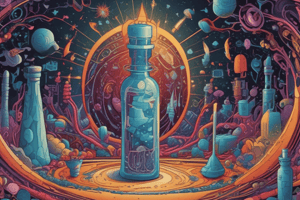Podcast
Questions and Answers
Which process primarily involves the conversion of active medications into compounds readily eliminated from the body?
Which process primarily involves the conversion of active medications into compounds readily eliminated from the body?
- Distribution
- Excretion
- Metabolism (correct)
- Absorption
A medication's bioavailability is best described as:
A medication's bioavailability is best described as:
- The rate and extent to which a drug's active ingredient is absorbed and becomes available at the site of action. (correct)
- The potential for a drug to cause adverse side effects in a patient.
- The chemical composition of the active ingredient in a drug.
- The process by which a drug is synthesized in a laboratory.
Which factor is LEAST likely to affect the absorption of a drug?
Which factor is LEAST likely to affect the absorption of a drug?
- The rate of blood flow to the absorption area.
- The patient's gender. (correct)
- The pH of the absorption environment.
- The surface area available for absorption.
A drug with a narrow therapeutic index (NTI) requires careful monitoring because:
A drug with a narrow therapeutic index (NTI) requires careful monitoring because:
Which route of drug elimination is NOT mentioned?
Which route of drug elimination is NOT mentioned?
If a drug is described as a 'prodrug' it means that:
If a drug is described as a 'prodrug' it means that:
According to the provided diagram, which tissues will have the slowest distribution of a drug?
According to the provided diagram, which tissues will have the slowest distribution of a drug?
A doctor increases the dose of a drug. What concept describes the relationship between the dose and the resulting concentration of the drug in the bloodstream?
A doctor increases the dose of a drug. What concept describes the relationship between the dose and the resulting concentration of the drug in the bloodstream?
Medications are used to treat a variety of conditions. Which of the options is NOT listed?
Medications are used to treat a variety of conditions. Which of the options is NOT listed?
Two different formulations of the same drug have the same bioavailability. This means that:
Two different formulations of the same drug have the same bioavailability. This means that:
Flashcards
Drug
Drug
A substance used to diagnose, treat, cure, prevent, or mitigate disease in humans or animals.
Pharmacology
Pharmacology
The scientific study of the action of drugs on a living system.
Pharmacokinetics
Pharmacokinetics
The study of drug's absorption, distribution, metabolism, and excretion in a living system.
Absorption (of a drug)
Absorption (of a drug)
Signup and view all the flashcards
Distribution (of a drug)
Distribution (of a drug)
Signup and view all the flashcards
Metabolism (of a drug)
Metabolism (of a drug)
Signup and view all the flashcards
Elimination (of a drug)
Elimination (of a drug)
Signup and view all the flashcards
Bioavailability
Bioavailability
Signup and view all the flashcards
Bioequivalence
Bioequivalence
Signup and view all the flashcards
Narrow Therapeutic Index (NTI)
Narrow Therapeutic Index (NTI)
Signup and view all the flashcards
Study Notes
- A drug is a substance used to diagnose, treat, cure, prevent, or mitigate disease in humans or animals.
Pharmacology
- Defined as the scientific study of the action of drugs on a living system.
- A medication interacts with receptors to produce a biological response.
Pharmacokinetics
- Involves the absorption, distribution, metabolism, and elimination (excretion) of a drug in a living system.
- Absorption is the manner by which drug molecules travel from the site of administration, across cell membranes, and into the circulatory system.
- Absorption is affected by pH, blood flow, body surface area, contact time at the absorption surface, and tissue thickness.
- Distribution is the means by which the drug travels from the circulatory system across barrier membranes to the site of action.
- Drug distribution is affected by the drug's properties, protein binding, and anatomical barriers.
- A drug's metabolism is affected by the liver's condition, disease states, a patient's age, their genetics, nutritional status, and gender.
- Metabolism is the process involving the conversion of active drugs to a compound that can be easily removed or the conversion of prodrugs to active drugs.
- Elimination (excretion) is the process by which a drug is removed from the body.
- Drugs are eliminated by the kidney, lung, and bowel.
- Factors affecting a drug's elimination include disease states, a drug's ionization, drug interactions, and a drug's half life.
Bioavailability
- The rate and extent to which the active ingredient or active entity is absorbed from a drug product and becomes available at the site of action.
Bioequivalence
- The rate and extent of absorption of an active ingredient from a drug product so that it becomes available at its site of action.
Narrow Therapeutic Index
- Narrow Therapeutic Index (NTI) drugs are drugs for which small differences in dose or blood concentration may lead to dose- and blood concentration-dependent, serious therapeutic failures or adverse drug reactions.
- Serious events are those that are persistent, irreversible, slowly reversible, or life-threatening, possibly resulting in hospitalization, disability, or even death.
- Characteristics of NTI drugs: Steep drug dose-response relationship within the usual dose range or narrow span between effective concentrations.
Drug Distribution
- Involves high blood flow and rapid distribution to the brain, heart and kidneys.
- Involves low blood flow and slow distribution to the skin, skeletal muscle and adipose tissue.
Studying That Suits You
Use AI to generate personalized quizzes and flashcards to suit your learning preferences.
Related Documents
Description
This lesson defines drugs and explores pharmacology, the study of drug action on living systems. It covers pharmacokinetics, including drug absorption, distribution, metabolism, and elimination. Factors influencing absorption and distribution are also discussed.




